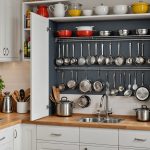Creating a cohesive theme in your kitchen design is akin to setting the stage for a culinary symphony. It’s about balancing aesthetics with functionality to craft an inviting space that reflects your taste and lifestyle. Whether you’re embarking on a major renovation or a simple refresh, a unified theme elevates the ambiance and enhances daily enjoyment. In this guide, we’ll explore the essential elements to harmonize your kitchen, ensuring that every detail resonates with your vision.
Selecting a Color Palette
Colors speak volumes in any design, and your kitchen is no exception. The right color palette sets the tone, influencing the atmosphere and mood. Choosing colors is more than just picking shades; it’s about creating a dialogue between elements that tell a story.
In the same genre : What are the best techniques for meal prepping for dietary restrictions?
Understanding Color Psychology
Colors evoke emotions and can significantly impact how you experience your kitchen. For instance, blues and greens often bring a sense of tranquility, while yellows and reds can add warmth and vibrancy. Consider what feelings you want to evoke in your space.
Harmonizing with Existing Elements
Evaluate the current fixtures and finishes in your kitchen. If you have stainless steel appliances, consider a palette that complements their sleek, modern look. For wooden cabinetry, earth tones or soft pastels might be more appealing.
Also to discover : How can I create a welcoming kitchen environment for family gatherings?
Creating Contrast and Balance
While a monochromatic scheme can be soothing, adding pops of contrasting colors can introduce dynamism. Think of accent walls, colorful backsplashes, or vibrant kitchen islands to create a focal point without overwhelming the senses.
Choosing the perfect palette is an art form in itself, one that requires thoughtful consideration of your kitchen’s unique character and your personal style.
Incorporating Textures and Materials
Textures and materials are the unsung heroes of design, adding depth and interest to your kitchen theme. By thoughtfully incorporating various elements, you can transform an ordinary space into a tactile paradise.
Mixing and Matching Materials
Don’t shy away from mixing different materials. Combining wood, metal, and glass can create an eclectic yet cohesive feel. Wooden countertops paired with metal fixtures can offer a rustic-industrial charm, while glass accents in cabinetry can introduce a modern touch.
Emphasizing Natural Materials
Natural materials like stone and wood not only bring warmth but also add an organic element that enhances authenticity. Consider granite or marble countertops for a luxurious feel, or opt for bamboo for a more sustainable choice.
Playing with Textures
Textures create visual interest and tactile experiences. Rough-hewn wooden surfaces, glossy tiles, and matte finishes can all coexist harmoniously. Ensure there’s a balance so no single texture overshadows another, maintaining an equilibrium throughout your kitchen.
Integrating thoughtful textures and materials helps to craft a multi-dimensional space that is both visually appealing and invitingly tactile.
Lighting: The Unsung Hero
Lighting is pivotal in tying together a kitchen’s theme, yet its role is often underestimated. Proper lighting not only enhances visibility but also elevates the overall ambiance and highlights the design elements within your kitchen.
Layered Lighting Approach
Consider a layered lighting strategy. Ambient lighting provides overall illumination, task lighting focuses on specific areas like the countertops or stove, and accent lighting highlights architectural features or artistic details. Together, these layers create a well-lit environment that feels welcoming.
Choosing the Right Fixtures
The style of your light fixtures can significantly impact your kitchen’s theme. Pendant lights can offer a modern touch, while chandeliers might add elegance. Consider the scale and placement to ensure they complement rather than overpower other design elements.
Using Natural Light
Maximizing natural light can drastically enhance your kitchen’s atmosphere. Use light curtains or blinds that allow sunlight to flood the room, casting a warm glow over your design.
Lighting is the finishing touch that defines the mood and brings your kitchen’s cohesive theme to life.
Accessorizing Smartly
Accessories might seem like minor details, but they play a crucial role in reinforcing a kitchen’s cohesive theme. Thoughtfully selected, they add personality and can be the final flourish in your design masterpiece.
Functional and Aesthetic Accessories
Choose accessories that are both functional and visually appealing. Consider stylish storage solutions that keep your kitchen organized while adding to its aesthetic charm. Items like attractive jars, utensil holders, and chic dish racks can serve dual purposes.
Coordinating Decorative Elements
Tie in colors and textures from your primary design theme in your accessories. A bright-colored fruit bowl or patterned tea towels can echo accent colors, while sleek cookware or decorative cutting boards can reinforce the chosen materials.
Personal Touches
Incorporate items that reflect your personality and interests. Whether it’s a collection of vintage salt shakers or a curated selection of cookbooks, these personal touches add warmth and character to your kitchen.
Smart accessorizing ensures that your kitchen remains cohesive and representative of your unique style, making it truly feel like home.
Creating a cohesive theme in your kitchen design involves a harmonious blend of color, texture, lighting, and accessories. Each element plays a pivotal role in crafting a space that is not only visually stunning but also reflects your personal style and enhances your daily life. By thoughtfully selecting and integrating these components, you can transform your kitchen into a sanctuary that inspires culinary creativity and offers a warm gathering place for family and friends. As you embark on this design journey, remember that cohesion is not about uniformity but about the seamless integration of diverse elements that speak to you. In doing so, you’ll create a kitchen that is both functional and a true reflection of your essence.











